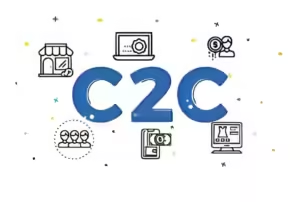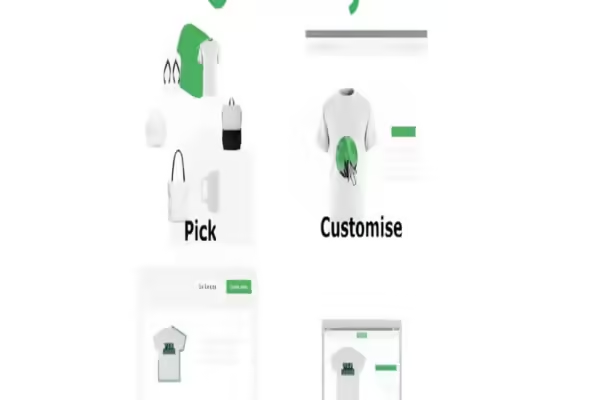In the dynamic environment of eCommerce, Consumer-to-Consumer (C2C) has been one of the most budding models of online transactions between buyers and sellers.
This post will explain what exactly C2C eCommerce is, and by providing some real examples across the web, you can get more insight into how it has started to function and help marketplace owners avail said benefits.
We will also be doing the advantages and disadvantages for the buyers and sellers, a robust business model, integrated payment processing, niche market opportunities, connecting with the right market, and the role of crowdfunding associated with C2C in modern business.
In the end, we will just bring down the important factor of C2C into modern business and a few popular FAQs.
What Is C2C eCommerce?

C2C eCommerce is referred to as transactions that are directly trained between consumers. Unlike B2B (Business-to-Business) or B2C (Business-to-Consumer) models, it aids people to sell products and services to other individuals. This is made possible through a third party online platform. The third-party platforms create online venues where the buyers and sellers may come close and conduct their negotiations besides carrying out a transaction.
Examples of C2C eCommerce.
A number of these C2C platforms have become very popular by leveraging the model:
eBay—One of the pioneers in C2C eCommerce. Its users can offer or auction off items directly to other consumers.
Etsy—It focuses on handmade, vintage, and unique factory-manufactured items, thus targeting a niche market for artisans and independent small business owners.
Airbnb—This is a form of C2C in the hospitality industry in that hosts reach out to potential guests.
Depop—A social shopping application for users to buy and sell their fashion items. Mainly focuses on pre-owned and vintage clothing.
Benefits of C2C:

Selling through a C2C marketplace is beneficial in that it provides the owner of the marketplace different advantages, such as:
Lower Inventory Costs: The platform does not hold any inventory itself, so less upfront investment is placed in stocking products.
Scalability: The platform grows organically with users who are choosing it and listing their items, thus creating a self-sustaining ecosystem.
Revenue Generation: Listing and transaction fees, along with premium services for users, make for considerable income generation. The user communities created in most C2C platforms enhance loyalty and repeat business in most cases.
How to find the right C2C platform?
The ideal C2C platform choice depends on several factors, such as:
User Base:
Check if the user base of your chosen platform is active and engaged.
Easy to Use:
Make sure that the user interface is easy, and that the flow of transactions would be smooth.
Security:
Strong security measure is taken to protect users’ personal and financial information.
Reputation:
Its reputation and customer reviews are needed.
Advantages and Disadvantages:
Advantages For Buyers:
Low Prices: Prices under C2C are generally lower than that of traditional retailing presentation due to the abridged cost.
Selection: Good selection of unique, vintage, or handmade products
Disadvantages to Buyers:
Fraud Risk: Because some of the sellers may be bogus and fake.
No Guarantees: There are very fewer guarantees offered on most of the occasions as compared to if a retail store is dealing with customers directly.
Pros: from Sellers’ End Low Barriers to Entry There are less barriers to entry and virtually no startup costs.
Global Market: without Shop Seller gets to enter the global market without actually maintaining one’s shop.
Flexibility: Can sell any number of items and does not need to maintain any inventory.
Cons from Sellers’: End Intense Competition High competition pushes prices down.
Delay in Payments: Delay in Receiving Payments.
How to Develop C2C Business Model?
To make an effective business model for C2C, the following details should be comprised of various elements, which are as follows:
User Acquisition and Retention:
Acquire new users by using referral programs followed by loyalty rewards and so on.
Revenue Sources:
Multiple revenue sources need to be diversified, which includes transaction fees, premium memberships, and advertisement as well.
Customer Support:
Support customers with rich customer service to resolve the dispute and ensure a positive user experience.
Continuous Improvement:
Keep on updating platform from time to time based on user feedback and technological improvements.
Inbuilt C2C Payments Handling:
No C2C platform can succeed without fluid and secure payment processing. Here is what you have to keep in mind:
Multi Payment Gateway:
Make sure that the C2C platform that you are offering has all the popular payment methods.
Secure:
Powerful encryption and fraud detection mechanisms should safeguard the transactions.
User Friendly:
Ensure it’s a simple and intuitive process to make payments.
Niche markets open up enormous opportunities provided to C2C platforms. Focusing on niches in specific interest or community areas allows platforms to bring in users passionate about such themes and create loyal customer relationships. For example:
Vintage Clothing:
Depop serves fashion aficionados on the hunt for special, one-of-a-kind, vintage items.
Handmade Goods:
Etsy serves artisans and craft lovers desiring to buy or sell handmade and vintage items.
Zero in on the Right Market:
Different ways to zero in on the right market using online platforms are as follows:
This means focused marketing to relevant demographics and interests. Community building through forums, social media groups, and events would also help.
Influencer marketing:
Partner with influencers whose niches align with your platform.
Crowdfunding C2C Sites:
Crowdfunding is an excellent way to launch or expand any C2C platform. You can raise the money from like-minded individuals and platform supporters using mechanisms like Kickstarter or Indiegogo. Crowdfunding Advantages:
Market validation:
Validate your idea by gauging the interest of the public.
Raising initial funds:
Get the critical money for development or improving your platform.
Building an early user base:
Hence, get that early community of users interested in the success of your platform.
What Does C2C Mean to Modern Business?
It means that C2C eCommerce holds serious implications for modern businesses:
More Competition: C2C brings more competition for traditional retailers
New Streams of Revenue: C2C allows new flows of revenue to a business through transactions.
Innovation: With the rise of C2C platforms, it drives innovation in technology and new business models in e-commerce.
FAQ:
What is C2C e-commerce?
C2C eCommerce is an example of online transactions where the consumers directly sell and buy products or services with other consumers, and this is usually done through a third-party, middleman-intermediary platform.
How do C2C platforms actually monetize?
C2C platforms monetize through listing fees, transaction fees, premium services, and advertising.
What are the risks associated with C2C eCommerce?
Possible fraud, no guarantees, and direct competition between sellers.
How can the right C2C platform be targeted?
Consider the user base, usability, security, and reputation of the platform.
What is the level of significance attached to payment processing in C2C?
A smooth, secure payment processing system is important not just for transactions but also to gain the confidence of both buyers and sellers.
Conclusion:
C2C e-commerce offers a vibrant and evolving market space in which customers can interact directly with other customers. Understanding those nuances and how best to leverage such value will help individuals and organizations to get ahead in a wild and woolly space of real innovation.





